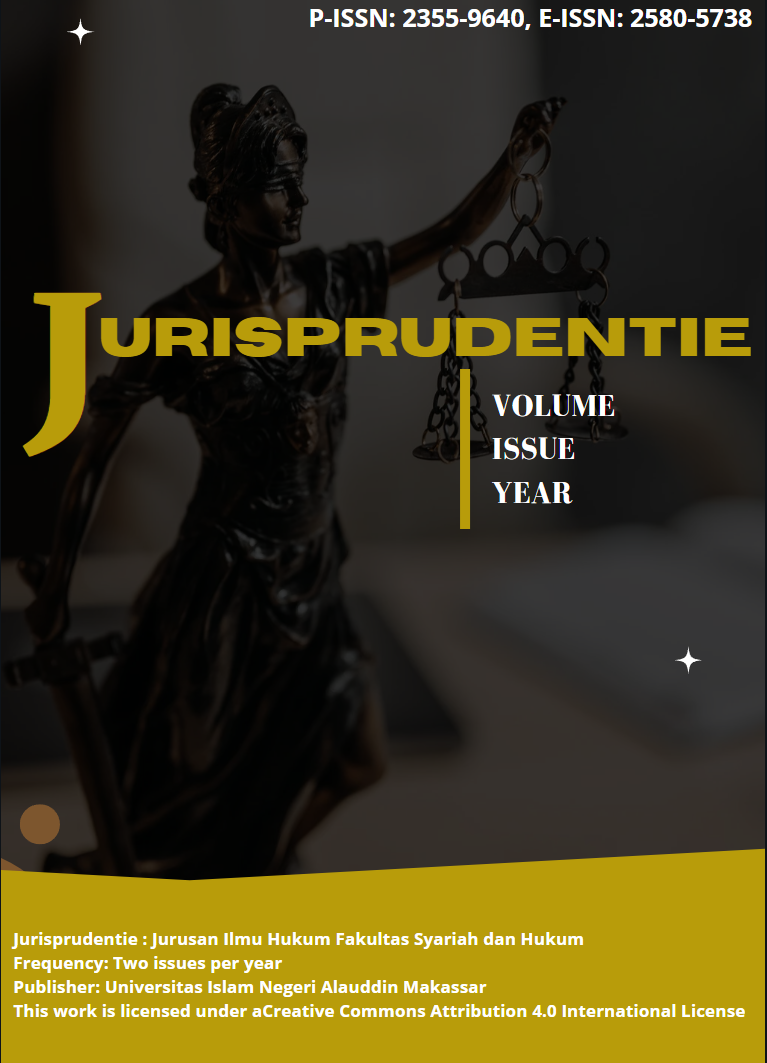ANALYSIS OF THE BALANCE OF INTEREST PROTECTION OF DEBTORS AND CREDIBTORS IN THE BANKRUPTCY LAW
Abstrak
The Bankruptcy Law is intended to maintain business continuity, not only debtors but also creditors and parties who are indirectly involved in the bankruptcy case. The purpose of the Bankruptcy Law is not to impoverish debtors and creditors and other parties but to ensure how after the bankruptcy decision the parties can resume their business or start a business again from scratch. The research approach used in this research is qualitative. The type of research is library research or normative juridical. Sources of data come from laws, journals, and books related to the Bankruptcy Law. The method of data collection is done through documentation in the form of books and journals. The data obtained were then processed and analyzed prescriptively and descriptively. Data processing is carried out by systematizing legal materials by classifying data to facilitate analysis and construction in normative legal research. The results of this study indicate that the Bankruptcy Law as far as possible maintains the balance of rights of debtors and creditors. Article 2 Paragraph (1) In simple terms, the procedure for bankruptcy of a person is also excluded if the debtor is hopelessly in debt or has no hope of continuing his business. Article 2 Paragraphs (2), (3), (4) and (5) provide limited access for certain lines to be bankrupt, seeing that these lines are in direct contact with the interests of the general public. Article 4 aims to maintain family harmony. Article 41 to maintain the continuity of the creditor's business when the debtor is in the process of bankruptcy.Referensi
Journal
Aprita, Serlika dan Rio Adhitya. “Penerapan “Asas Keadilan” dalam Hukum Kepailitan sebagai Perwujudan Perlindungan Hukum bagi Debitor.” Jurnal Hukum Media Bhakti Volume 3 Nomor 1 (Juni 2019).
Butarbutar, Elisabeth Nurhaini. “Pembuktian terhadap Perbuatan Debitur yang Merugikan Kreditur dalam Tuntutan Actio Pauliana.” Jurnal Yudisial Volume 12 Nomor 2 (Agustus 2019).
Irianto, Catur. “Penerapan Asas Kelangsungan Usaha dalam Penyelesaian Perkara Kepailitan dan Penundaan Kewajiban Pembayaraan Utang (PKPU).” Jurnal Hukum dan Peradilan Volume 4, Nomor 3 (November 2015).
Nawawi, Kholil. “Harta Bersama Menurut Hukum Islam dan Perundang-undangan di Indonesia.” Mizan; Jurnal Ilmu Syariah Volume 1 Nomor 1 (2013).
Simalango, Maruli. “Inkonsistensi Persyaratan Permohonan Pailit dihubungkan dengan Asas Kelangsungan Usaha (Going Concern) dalam Undang-Undang No. 37 Tahun 2004 tentang Kepailitan dan Penundaan Kewajiban Pembayaran Utang.” Syiar Hukum Jurnal Ilmu Hukum Volume 15 Nomor 1 (2017).
Sinaga, Niru Anita dan Nunuk Sulisrudatin, “Hukum Kepailitan dan Permasalahannya di Indonesia.” Jurnal Ilmiah Hukum Dirgantara Volume 7 Nomor 1 (September 2016).
Sularto. “Perlindungan Hukum Kreditor Separatis dalam Kepailitan.” Mimbar Hukum Volume 24 Nomor 2 (2012).
Swari, Ida Ayu Kade Winda. et al. “Perlindungan Hukum terhadap Kepentingan Para Kreditor Akibat Actio Pauliana dalam Hukum Kepailitan.” Kertha Semaya Volume 02 Nomor 01 (Februari 2014).
Wijayanta, Tata. “Asas Kepastian Hukum, Keadilan dan Kemanfaatan dalam Kaitannya dengan Putusan Kepailitan Pengadilan Niaga.” Jurnal Dinamika Hukum Volume 14, Nomor 2 (Mei 2014).
Book
Harahap, M. Yahya. Hukum Perseroan Terbatas. Jakarta: Sinar Grafika, 2009.
Mertokusumo, Sudikno. Mengenal Hukum (Suatu Pengantar). Yogyakarta: Liberty, 1991.
Soeroso, R. Pengantar Ilmu Hukum. Jakarta: Sinar Grafika, 2015.
Soejono dan Abdurrahman, H. Metode Penelitian Hukum. Jakarta: Rineka Cipta, 2003.
Soekanto, Soerjono. Pengantar Penelitian Hukum. Jakarta: UI Press, 2012.
Wijayanta, Tata. Undang-Undang dan Praktik Kepailitan: Perbandingan Indonesia dan Malaysia, Yogyakarta: Gadjah Mada University Press, 2016.
Once an article was published in the journal, the author(s) are:
- to retain copyright and grant to the journal right licensed under Creative Commons License Attribution that allows others to share the work with an acknowledgement of the work's authorship.
- permitted to publish their work online in third parties as it can lead wider dissemination of the work, with an acknowledgement of its initial publication in this journal
- continue to be the copyright owner and allow the journal to publish the article with the CC BY license
- receiving a DOI (Digital Object Identifier) of the work.


